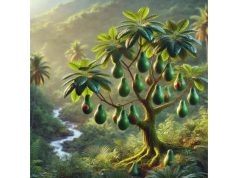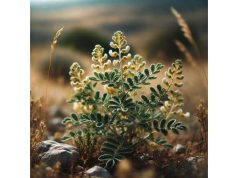Australian Tea Tree, derived from the leaves of Melaleuca alternifolia, is a world-renowned herb celebrated for its potent essential oil and remarkable healing properties. Native to Australia, this evergreen tree has long been used by Indigenous Australians for its antiseptic, anti-inflammatory, and antimicrobial benefits. Today, Australian Tea Tree oil is a staple in both traditional and modern natural medicine, prized for its ability to support skin health, promote wound healing, and provide a natural defense against a variety of pathogens. Rich in terpenes such as terpinen-4-ol, cineole, and α-terpineol, this herb plays an integral role in aromatherapy, topical formulations, and even household cleaning products. Its legacy spans centuries—from Indigenous medicinal practices to its global application in contemporary health and beauty industries.
- powerful antimicrobial and antiseptic properties that help fight bacteria and fungi
- Its anti-inflammatory benefits that soothe skin irritations and accelerate wound healing
- Its versatility in aromatherapy, skincare, and natural cleaning products
- Its longstanding traditional use among Indigenous Australians for healing and protection
- Its robust, naturally derived composition that supports overall skin and respiratory health
Table of Contents
- Australian Tea Tree: Botanical Profile and Characteristics
- Australian Tea Tree: Historical Background and Cultural Significance
- Australian Tea Tree: Active Compounds and Phytochemical Composition
- Australian Tea Tree: Health Benefits and Therapeutic Properties
- Australian Tea Tree: Uses, Applications, and Safety Guidelines
- Australian Tea Tree: Recent Studies and Scientific Insights
- Australian Tea Tree: Frequently Asked Questions
Australian Tea Tree: Botanical Profile and Characteristics
Taxonomy and Botanical Description
Australian Tea Tree is scientifically known as Melaleuca alternifolia, a member of the Myrtaceae family. Indigenous to the subtropical coastal regions of New South Wales and Queensland in Australia, it is a small to medium-sized tree or shrub that thrives in moist, well-drained soils. Its narrow, lanceolate leaves are covered with fine oil glands that secrete the potent essential oil for which the tree is famous.
- Family: Myrtaceae
- Genus: Melaleuca
- Species: Melaleuca alternifolia
Morphological Features
- Leaves:
The leaves of the Australian Tea Tree are slender, pointed, and have a bluish-green hue. These leaves are the primary source of the essential oil, which is extracted through steam distillation. Their high concentration of oil glands gives them a characteristic, fresh aroma. - Bark and Growth Habit:
The bark is typically papery and peels off in layers, which is a distinctive feature of many Melaleuca species. The plant usually grows as a shrub or small tree, reaching heights of 2 to 7 meters, and develops a bushy, rounded crown. - Flowers:
In late spring and summer, the tree produces clusters of small, white, bottlebrush-like flowers. These flowers attract a variety of pollinators, including bees and butterflies, contributing to its ecological significance.
Optimal Growing Conditions
- Climate:
Native to humid subtropical regions, Australian Tea Tree thrives in warm, humid environments with plenty of rainfall. It prefers full sun but can tolerate partial shade. - Soil:
The tree grows best in well-drained, sandy to loamy soils. It is resilient in poor soils, which makes it ideal for cultivation in various environments. - Propagation:
Propagation is typically achieved through cuttings, which ensures that the high-quality oil-producing traits are maintained. It is also grown from seeds, though this method may produce more variability in essential oil content.
Ecological Importance
Australian Tea Tree plays a vital role in its native ecosystem:
- Biodiversity:
Its flowers attract pollinators, contributing to local biodiversity. - Soil Conservation:
The tree’s extensive root system helps stabilize soil, reducing erosion in its native habitat. - Cultural Significance:
Indigenous Australians have long valued this tree for its medicinal properties and its role in natural landscapes.
Australian Tea Tree: Historical Background and Cultural Significance
Indigenous Use and Traditional Knowledge
For millennia, Indigenous Australians have harnessed the healing properties of Australian Tea Tree. The traditional knowledge passed down through generations emphasizes its use as a natural antiseptic and healing agent.
- Traditional Medicine:
Indigenous communities used crushed leaves and twigs to treat wounds, skin infections, and respiratory ailments. The strong antiseptic properties of the oil were recognized as a powerful means to prevent infection and promote healing. - Ritual and Cultural Use:
Beyond its medicinal applications, Australian Tea Tree held cultural significance, often used in rituals and as a symbol of purification and protection.
Colonial and Modern Adoption
- European Discovery:
European settlers in Australia quickly adopted the use of Australian Tea Tree, integrating it into their medicinal practices. Its potent essential oil was noted for its ability to treat a variety of infections and was incorporated into early antiseptic solutions. - Global Expansion:
Over the 20th century, scientific advancements led to the isolation and study of Tea Tree oil, propelling it into global popularity. Today, it is widely used in alternative medicine, skincare products, and natural remedies around the world. - Modern Applications:
Modern research has further validated its traditional uses, particularly its antimicrobial, anti-inflammatory, and antifungal properties. This scientific backing has solidified Australian Tea Tree’s status as a natural powerhouse in contemporary health and wellness industries.
Cultural Impact
- Symbol of Natural Healing:
Australian Tea Tree remains a symbol of natural healing and sustainable use of botanical resources. Its integration into modern cosmetics and pharmaceuticals underscores its lasting impact. - Economic Importance:
The cultivation and export of Australian Tea Tree oil have become significant for local economies, particularly in Australia, where strict quality standards ensure its premium status in international markets.
Australian Tea Tree: Active Compounds and Phytochemical Composition
The therapeutic properties of Australian Tea Tree oil are attributed to its complex phytochemical profile. The essential oil is composed of numerous bioactive compounds that work synergistically to provide antimicrobial, anti-inflammatory, and healing effects.
Terpinen-4-ol
- Key Component:
Terpinen-4-ol is widely recognized as the most important active compound in Australian Tea Tree oil. It is largely responsible for the oil’s antimicrobial and antifungal properties. - Mechanism of Action:
Studies suggest that terpinen-4-ol disrupts the cell membranes of bacteria and fungi, leading to their inactivation, which makes the oil effective in treating skin infections and wounds.
Cineole and α-Terpineol
- Aromatic and Therapeutic Effects:
These compounds contribute to the distinctive aroma of Tea Tree oil and enhance its anti-inflammatory and antiseptic properties. - Respiratory Benefits:
Cineole, in particular, is known for its expectorant properties, helping to clear respiratory passages and relieve symptoms of colds and congestion.
α-Pinene and Limonene
- Antioxidant Activity:
α-Pinene and limonene add to the overall antioxidant profile of Australian Tea Tree oil, helping to neutralize free radicals and reduce oxidative stress. - Synergistic Effects:
These terpenes work in concert with other components to enhance the oil’s efficacy in promoting skin health and reducing inflammation.
Other Bioactive Compounds
- Sesquiterpenes and Alcohols:
A range of sesquiterpenes and alcohols in the oil contribute to its overall antimicrobial and anti-inflammatory activities. - Trace Nutrients:
Though present in smaller quantities, trace nutrients and other minor compounds add to the holistic therapeutic profile of the oil.
Synergy and Overall Efficacy
The combined effects of these bioactive compounds result in a potent natural remedy. The synergy between terpinen-4-ol, cineole, α-terpineol, and other constituents not only makes Australian Tea Tree oil highly effective against a broad spectrum of pathogens but also supports its use in soothing inflamed skin and promoting wound healing.
Australian Tea Tree: Health Benefits and Therapeutic Properties
Australian Tea Tree oil has earned global acclaim for its diverse range of health benefits, which have been validated by both traditional practices and modern scientific research. Its potent antimicrobial, anti-inflammatory, and healing properties make it a versatile tool in natural medicine.
1. Antimicrobial and Antifungal Effects
- Broad-Spectrum Activity:
The oil’s ability to combat bacteria, viruses, and fungi is well-documented. Terpinen-4-ol, cineole, and other constituents work together to inhibit microbial growth, making it an effective treatment for skin infections, acne, and other microbial conditions. - Wound Healing:
Applied topically, Australian Tea Tree oil can help cleanse wounds, prevent infection, and accelerate healing. Its antiseptic properties create an environment that supports tissue repair.
2. Anti-Inflammatory Properties
- Reduction of Inflammation:
Australian Tea Tree oil is known for its ability to reduce inflammation, which can help alleviate symptoms of skin conditions such as eczema, psoriasis, and dermatitis. - Soothing Irritated Skin:
When diluted and applied to the skin, the oil can calm redness, swelling, and irritation, promoting a clearer, healthier complexion.
3. Skin Health and Cosmetic Benefits
- Acne and Blemish Treatment:
The antimicrobial and anti-inflammatory actions of the oil make it an effective treatment for acne. It helps reduce the bacteria that cause breakouts and minimizes inflammation around the affected areas. - Antioxidant Protection:
Its antioxidant compounds protect the skin from oxidative stress, reducing the appearance of aging and supporting overall skin health. - Topical Use in Cosmetics:
Australian Tea Tree oil is a common ingredient in skincare products such as cleansers, toners, and creams due to its ability to purify and refresh the skin.
4. Respiratory and Inhalation Benefits
- Clearing Congestion:
The volatile compounds in the oil, particularly cineole, have expectorant properties that help clear mucus from the respiratory tract. Inhalation of diluted Tea Tree oil vapors can relieve symptoms of colds and sinus congestion. - Aromatherapy Applications:
When used in aromatherapy diffusers, the oil’s refreshing scent can help reduce stress, improve mental clarity, and promote overall respiratory health.
5. Immune Support and General Well-being
- Enhancing Immune Function:
The antimicrobial and antioxidant properties of Australian Tea Tree oil contribute to a stronger immune response. It helps the body fend off infections and supports overall health. - Holistic Health Tonic:
While primarily used topically, some holistic practices incorporate diluted Tea Tree oil into massage oils or bath preparations to promote a sense of well-being and relaxation.
6. Additional Therapeutic Applications
- Oral Hygiene:
Australian Tea Tree oil is also used in dental care products for its antibacterial properties, which can help maintain oral hygiene and prevent gum disease. - Household Uses:
Beyond its medicinal and cosmetic applications, the oil is valued for its natural disinfectant properties, making it a popular ingredient in eco-friendly cleaning products.
Together, these health benefits demonstrate the versatility of Australian Tea Tree oil as a natural remedy for a wide range of conditions, from skin and respiratory issues to immune support and overall wellness.
Australian Tea Tree: Uses, Applications, and Safety Guidelines
Therapeutic and Cosmetic Applications
- Topical Applications:
- Skin Care:
Diluted Australian Tea Tree oil is widely used in skincare for its ability to treat acne, soothe irritated skin, and reduce inflammation. It can be added to creams, lotions, or applied directly (when properly diluted) to affected areas. - Wound Care:
Due to its antimicrobial properties, the oil is often used to cleanse minor cuts, abrasions, and insect bites, helping to prevent infection and promote healing.
- Aromatherapy:
- Diffusers and Inhalation:
The essential oil is used in diffusers to purify the air and provide respiratory support. Inhalation of the vapor can help clear nasal passages and reduce symptoms of congestion. - Stress Relief:
Its refreshing, antiseptic aroma is known to promote mental clarity and reduce stress, making it a common choice in aromatherapy blends.
- Household and Personal Care:
- Natural Disinfectant:
Australian Tea Tree oil is a popular ingredient in eco-friendly cleaning products, thanks to its strong antibacterial and antifungal properties. - Oral Hygiene:
Some mouthwashes and toothpaste formulations include Tea Tree oil to help reduce oral bacteria and support gum health.
Dosage and Administration
- Topical Use:
Always dilute Australian Tea Tree oil before topical application. A typical dilution ratio is 1-2 drops of oil per teaspoon of carrier oil (such as coconut or jojoba oil). - Aromatherapy:
Add 3-5 drops of the oil to a diffuser filled with water, or dilute a few drops in a bowl of hot water for steam inhalation. - Oral Hygiene:
For mouthwash, add 1-2 drops of Australian Tea Tree oil to a glass of water. Do not swallow; spit out after rinsing.
Safety Guidelines and Precautions
- General Use:
- Australian Tea Tree oil is potent and should always be used in diluted form. Direct application of undiluted oil may cause skin irritation.
- Allergic Reactions:
- Conduct a patch test before using the oil extensively. Discontinue use if redness, itching, or irritation occurs.
- Pregnancy and Breastfeeding:
- Pregnant or breastfeeding women should consult a healthcare provider before using Australian Tea Tree oil, as its safety has not been fully established in these populations.
- Ingestion:
- This essential oil is for external use only. Ingestion can be toxic.
- Interactions with Medications:
- While generally safe, individuals taking certain medications should consult with a healthcare provider before using essential oils to avoid potential interactions.
Following these guidelines can help ensure that you use Australian Tea Tree oil safely and effectively in both your personal care and household applications.
Australian Tea Tree: Recent Studies and Scientific Insights
Modern research continues to explore and validate the diverse benefits of Australian Tea Tree oil. Recent studies have provided valuable insights into its antimicrobial, anti-inflammatory, and therapeutic properties.
1. Antimicrobial and Antifungal Efficacy
- Study (2018), Journal of Applied Microbiology:
Research has demonstrated that Australian Tea Tree oil is effective against a broad spectrum of bacteria and fungi, including strains resistant to conventional antibiotics. The study highlighted its potential in treating skin infections and supporting wound healing. - In Vitro Findings (2019):
Laboratory studies have shown that terpinen-4-ol, one of the primary constituents of Tea Tree oil, disrupts microbial cell membranes, leading to the inactivation of pathogens. These findings support its use as a natural antiseptic.
2. Anti-Inflammatory and Skin Healing Properties
- Clinical Trial (2020), Dermatologic Therapy:
A clinical trial involving patients with mild to moderate acne found that topical formulations containing diluted Australian Tea Tree oil significantly reduced inflammation and improved skin appearance. Participants reported fewer breakouts and decreased redness. - Mechanistic Insights:
Further research has elucidated that the anti-inflammatory effects of the oil are due to the inhibition of pro-inflammatory cytokines, which helps reduce skin irritation and supports the healing process.
3. Respiratory Benefits and Aromatherapy Applications
- Research (2021), Evidence-Based Complementary and Alternative Medicine:
Studies indicate that inhalation of Australian Tea Tree oil vapors can improve respiratory function by reducing nasal congestion and clearing the airways. Its expectorant properties also aid in relieving coughs and colds. - Aromatherapy Observations:
Clinical observations suggest that diffusion of the oil in indoor environments can contribute to improved air quality and enhanced mood, reinforcing its use in aromatherapy.
Australian Tea Tree: Frequently Asked Questions
Is Australian Tea Tree oil safe for topical use?
Yes, when properly diluted, Australian Tea Tree oil is safe for topical use. It is widely used to treat acne, minor cuts, and skin irritations. Always conduct a patch test to check for any allergic reaction before extensive use.
Can Australian Tea Tree oil help with respiratory issues?
Australian Tea Tree oil is used in aromatherapy to help clear nasal congestion and relieve respiratory discomfort. However, it should not be ingested and should be used only in a diffuser or diluted for steam inhalation.
What are the main active components of Australian Tea Tree oil?
The most important active components include terpinen-4-ol, cineole, and α-terpineol. These compounds contribute to its antimicrobial, anti-inflammatory, and antifungal properties.
How should I use Australian Tea Tree oil for skin care?
Dilute a few drops of Australian Tea Tree oil in a carrier oil (such as coconut or jojoba oil) and apply it to the affected area. It can also be added to creams or lotions. Avoid using undiluted oil directly on the skin to prevent irritation.
Disclaimer:
This article is for educational purposes only and should not be considered a substitute for professional medical advice. Always consult a qualified healthcare provider before starting any new herbal regimen, particularly if you have underlying health conditions or are taking prescription medications.
If you found this comprehensive guide on Australian Tea Tree valuable, please share it on Facebook, X (formerly Twitter), or your preferred social media platform. Sharing this information helps others discover the natural benefits and rich heritage of this potent herb!














